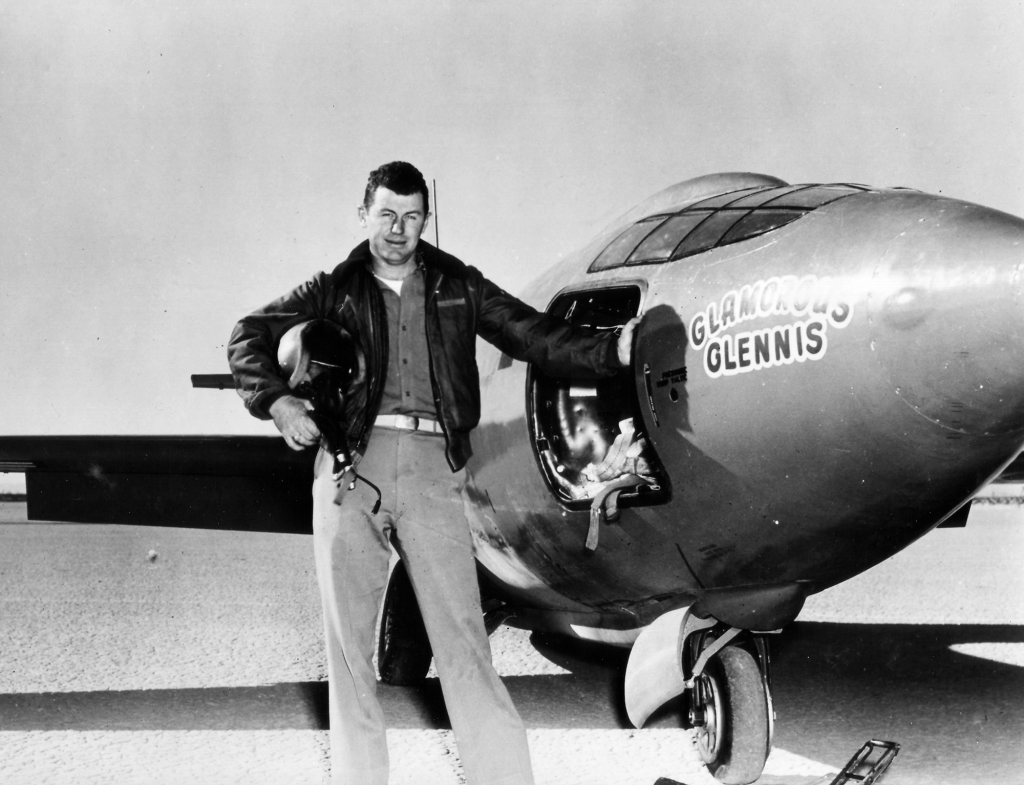
Early Life and Inspiration
Charles Elwood “Chuck” Yeager was born on February 13, 1923, in Myra, West Virginia. Raised in a small rural town, Yeager developed a natural curiosity for mechanics and machinery, skills that would later serve him well as both a fighter pilot and a test pilot. His modest upbringing instilled in him resilience, determination, and a sense of discipline that became hallmarks of his military career.
World War II Fighter Ace
Yeager enlisted in the U.S. Army Air Forces in 1941 and quickly demonstrated exceptional flying skills. During World War II, he served as a fighter pilot in the European theater, where he flew the P-51 Mustang. Despite being shot down over France, he evaded capture with the help of the French Resistance and returned to combat. Yeager went on to achieve ace status, credited with downing 11 enemy aircraft, including five in a single mission.
His wartime service not only proved his courage but also showcased his technical understanding of aircraft performance, which would make him a natural candidate for future test pilot assignments.
Breaking the Sound Barrier
On October 14, 1947, Chuck Yeager etched his name into aviation history. Flying the Bell X-1 rocket plane, nicknamed “Glamorous Glennis” after his wife, Yeager became the first pilot to break the sound barrier, reaching Mach 1.06 at an altitude of 45,000 feet.
This achievement marked a turning point in aviation, dispelling fears that supersonic flight was impossible and opening the door to an entirely new era of aerospace engineering. Yeager’s flight over the Mojave Desert remains one of the most celebrated milestones in the history of aviation.
Test Pilot and Air Force Career
After the success of the X-1 program, Yeager continued to serve as a test pilot at Edwards Air Force Base, where he pushed the limits of experimental aircraft. His fearless approach and technical expertise earned him a reputation as one of the greatest aviators of his generation.
Throughout his distinguished Air Force career, Yeager rose to the rank of brigadier general. He held a variety of leadership positions, training pilots and shaping the future of American air power. His contributions extended far beyond his supersonic record — he played a central role in developing the test pilot culture that eventually fed into NASA’s astronaut corps.
Awards and Recognition
Yeager’s achievements earned him numerous accolades, including:
- The Collier Trophy (1948) for his supersonic flight.
- The Presidential Medal of Freedom (1985), one of the United States’ highest civilian honors.
- Multiple military decorations, including the Silver Star, Distinguished Flying Cross, and Bronze Star Medal.
His impact was recognized not only by the U.S. Air Force but also by the broader aerospace community worldwide.
Later Life and Legacy
Even after retiring from active duty in 1975, Yeager remained deeply connected to aviation. He continued to fly military and experimental aircraft as a consultant and frequently appeared at air shows, inspiring new generations of pilots and aviation enthusiasts.
In 1997, on the 50th anniversary of his historic supersonic flight, Yeager once again flew past the speed of sound — this time in an F-15 Eagle — proving his enduring connection to flight.
Chuck Yeager passed away on December 7, 2020, at the age of 97. His legacy endures not only in the history books but also in the spirit of innovation, bravery, and exploration that defines aviation.
Influence on Aviation and Popular Culture
Yeager’s story has been immortalized in books, documentaries, and films, most notably in Tom Wolfe’s The Right Stuff. His name remains synonymous with breaking barriers — both literal and figurative. For aviators, engineers, and dreamers alike, Chuck Yeager represents the ultimate pioneer who dared to do what many believed was impossible.
Chuck Yeager’s journey from a small-town boy in West Virginia to a global icon of aviation is a testament to courage, skill, and perseverance. As the first man to break the sound barrier, a decorated World War II ace, and a legendary test pilot, his contributions reshaped the future of flight.
His story continues to inspire all who look to the skies and imagine pushing beyond the limits of what seems possible.
